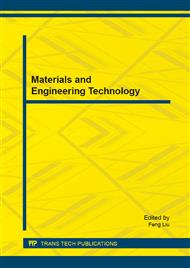[1]
Phadke, C., Uzunalioglu, H., Mendiratta, V. B., Kushnir, D., & Doran, D. (2013). Prediction of Subscriber Churn Using Social Network Analysis. Bell Labs Technical Journal, 17(4), 63-75.
DOI: 10.1002/bltj.21575
Google Scholar
[2]
Kawale, J., Pal, A., & Srivastava, J. (2009, August). Churn prediction in MMORPGs: A social influence based approach. In Computational Science and Engineering, 2009. CSE'09. International Conference on (Vol. 4, pp.423-428). IEEE.
DOI: 10.1109/cse.2009.80
Google Scholar
[3]
Richter, Y., Yom-Tov, E., & Slonim, N. (2010, April). Predicting Customer Churn in Mobile Networks through Analysis of Social Groups. In SDM (pp.732-741).
DOI: 10.1137/1.9781611972801.64
Google Scholar
[4]
Cheng, X., Lu, Q., He, L., Li, H., Wang, T., & Yang, D. (2010, August). Communities' discovery in mobile call records. In Fuzzy Systems and Knowledge Discovery (FSKD), 2010 Seventh International Conference on (Vol. 6, pp.2541-2545). IEEE.
DOI: 10.1109/fskd.2010.5569798
Google Scholar
[5]
Dasgupta, K., Singh, R., Viswanathan, B., Chakraborty, D., Mukherjea, S., Nanavati, A. A., & Joshi, A. (2008, March). Social ties and their relevance to churn in mobile telecom networks. In Proceedings of the 11th international conference on Extending database technology: Advances in database technology (pp.668-677.
DOI: 10.1145/1353343.1353424
Google Scholar
[6]
Ahn, H., Ahn, J. J., Byun, H. W., & Oh, K. J. (2011). A novel customer scoring model to encourage the use of mobile value added services. Expert Systems with Applications, 38(9), 11693-11700.
DOI: 10.1016/j.eswa.2011.03.054
Google Scholar
[7]
Archaux, Cedric, Arnaud Martin, and Ali Khenchaf. An SVM based churn detector in prepaid mobile telephony., Information and Communication Technologies: From Theory to Applications, 2004. Proceedings. 2004 International Conference on. IEEE, (2004).
DOI: 10.1109/ictta.2004.1307830
Google Scholar
[8]
Huang, B., Kechadi, M. T., & Buckley, B. (2012). Customer churn prediction in telecommunications. Expert Systems with Applications, 39(1), 1414-1425.
DOI: 10.1016/j.eswa.2011.08.024
Google Scholar
[9]
Nanavati, A. A., Gurumurthy, S., Das, G., Chakraborty, D., Dasgupta, K., Mukherjea, S., & Joshi, A. (2006, November). On the structural properties of massive telecom call graphs: findings and implications. In Proceedings of the 15th ACM international conference on Information and knowledge management (pp.435-444.
DOI: 10.1145/1183614.1183678
Google Scholar
[10]
Zhu, T., Wang, B., Wu, B., & Zhu, C. (2011). Role defining using behavior-based clustering in telecommunication network. Expert Systems with Applications, 38(4), 3902-3908.
DOI: 10.1016/j.eswa.2010.09.051
Google Scholar
[11]
Dierkes, T., Bichler, M., & Krishnan, R. (2011). Estimating the effect of word of mouth on churn and cross-buying in the mobile phone market with Markov logic networks. Decision Support Systems, 51(3), 361-371.
DOI: 10.1016/j.dss.2011.01.002
Google Scholar
[12]
Kusuma, P. D., Radosavljevik, D., Takes, F. W., & van der Putten, P. Combining Customer Attribute and Social Network Mining for Prepaid Mobile Churn Prediction.
Google Scholar
[13]
Delre, S. A., Jager, W., Bijmolt, T. H., & Janssen, M. A. (2010). Will it spread or not? The effects of social influences and network topology on innovation diffusion. Journal of Product Innovation Management, 27(2), 267-282.
DOI: 10.1111/j.1540-5885.2010.00714.x
Google Scholar
[14]
Guille, A., Hacid, H., Favre, C., & Zighed, D. A. (2013). Information diffusion in online social networks: A survey. ACM SIGMOD Record, 42(1), 17-28.
DOI: 10.1145/2503792.2503797
Google Scholar
[15]
Eagle, N., Pentland, A. S., & Lazer, D. (2009). Inferring friendship network structure by using mobile phone data. Proceedings of the National Academy of Sciences, 106(36), 15274-15278.
DOI: 10.1073/pnas.0900282106
Google Scholar
[16]
Dai, B. T., Chua, F. C. T., & Lim, E. P. (2012). Structural Analysis in Multi-Relational Social Networks. SIAM International Conference on Data Mining (SDM2012).
DOI: 10.1137/1.9781611972825.39
Google Scholar
[17]
Kempe, D., Kleinberg, J., & Tardos, É. (2005). Influential nodes in a diffusion model for social networks. In Automata, languages and programming (pp.1127-1138). Springer BerlinHeidelberg.
DOI: 10.1007/11523468_91
Google Scholar


